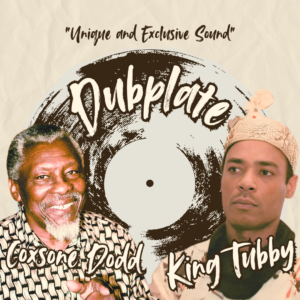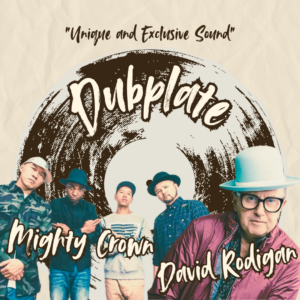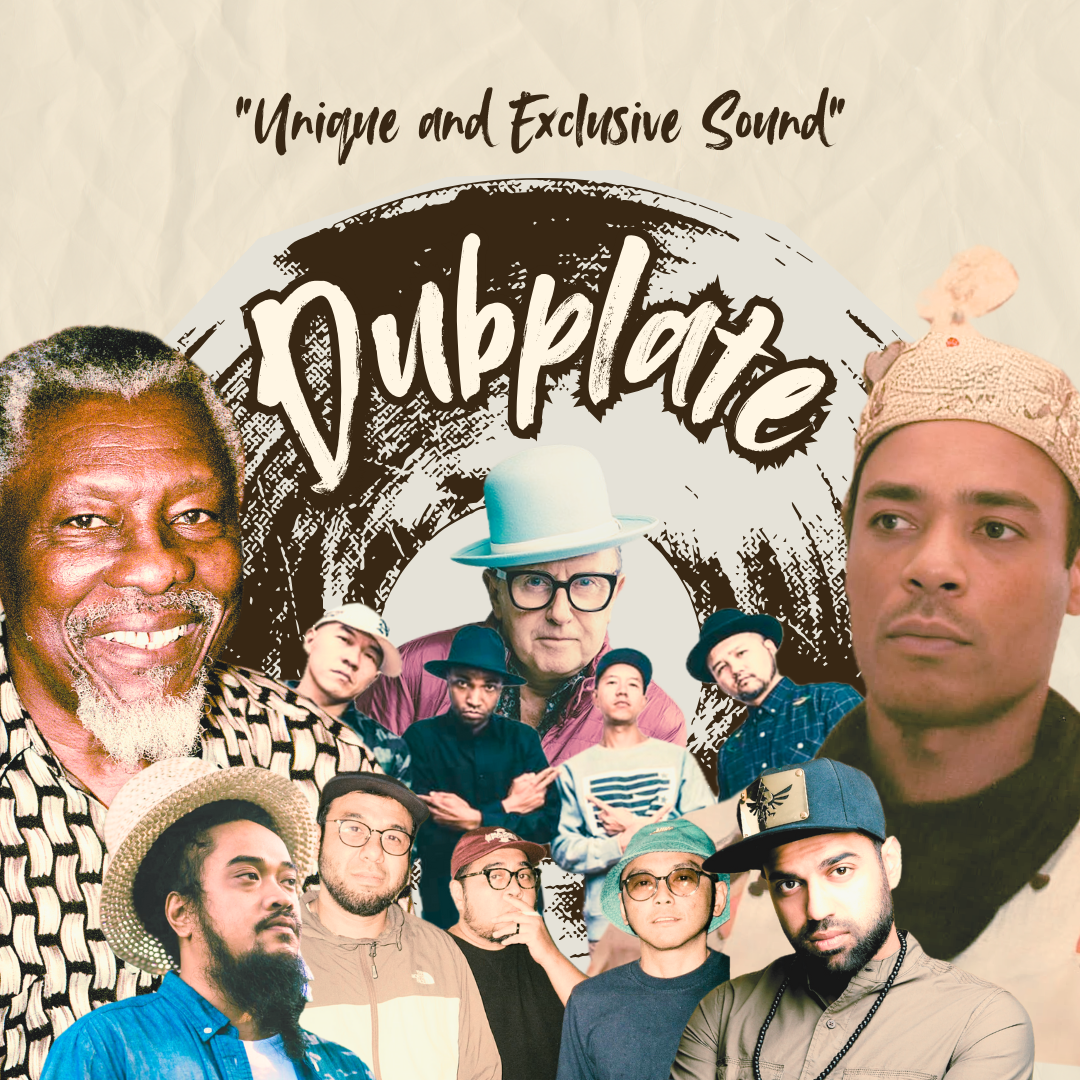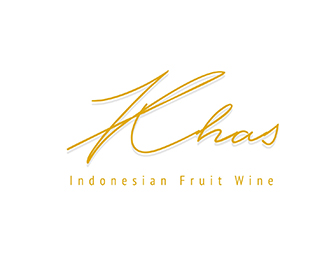A Unique and Exclusive Sound
“Imagine yourself in the middle of a sound clash. The atmosphere is heating up, the dance floor is ready to blaze the fire up. A selector drops the needle onto the record, and—boom!—the bass shakes the dance floor. But this isn’t just any track. The vocals have been altered, the lyrics call out the selector by name, and every beat hits sharper, heavier—crafted specifically for this moment.”
This is the power of a dubplate—a one-of-a-kind track, custom-made for a DJ or sound system, designed to hit harder than anything else on the dancefloor. More than just music, dubplates are status, strategy, and storytelling, shaping the way sound systems battle and win.
But dubplates are more than just a DJ’s secret weapon—they represent status, creativity, and the ever-evolving nature of music culture. David Rodigan once described sound clashes as a battleground where obsessive collectors go to extreme lengths to secure personalized recordings from top artists.
“It’s like a boxing match in music, and if done right, staying true to its tradition, it can be incredibly fun and exciting!”
Indeed, when clashes honor their roots, they become electrifying showcases of musical strategy. This legendary figure also emphasized that a sound clash is far from random—it demands meticulous preparation, from collecting dubplates and booking studio time to crafting a battle-ready playlist.
Origins
The concept of dubplates first emerged in the late 1950s to early 1960s, coinciding with the rise of sound system culture in Jamaica. At the time, sound systems (large speaker setups used for parties and outdoor events) became a major source of entertainment, especially for the working-class community who had limited access to the latest records.

To stand out from competitors, DJs and sound system operators sought exclusive music unavailable to the public. Dubplates became the answer: special recordings made exclusively for one sound system, allowing them to play versions of songs that could only be heard at their events. Initially, dubplates were mostly dub versions (instrumental reggae tracks with additional signature sound effects), but they soon evolved into full-length songs featuring shout-outs from artists, new lyrics, or even diss tracks aimed at rival sound systems during sound clashes.
During the 1960s and 1970s, dubplates played a crucial role in the development of reggae and dancehall, with King Tubby pioneering the art of dub mixing. As a studio engineer, he began crafting exclusive recordings for specific sound systems, giving them an edge in performances and battles. Alongside King Tubby, Coxsone Dodd (Sir Coxsone’s Downbeat) also laid the foundation for the incorporation of exclusive, limited recordings into sound system culture.
Manila-based selector Red-I highlights the significance of these pioneers, stating:
“The dubplate tradition grew through sound system culture and continued to evolve in electronic music. In the 1970s, King Tubby in Jamaica was one of the key figures who not only produced dub but also crafted dubplates in his own studio. Later, in the UK, Russ D, aka The Disciples, carried on the tradition in the early ’90s, creating dubplates that are still played in sessions today.”
Alteration
Though dubplates originated in Jamaica, their influence has spread across the world. In the UK, the Caribbean diaspora—especially those from the Windrush Generation—played a major role in introducing and adapting dubplates into reggae, jungle, and drum and bass scenes. Figures like David Rodigan, known for his exceptionally rare and exclusive dubplate collections, became key pioneers in the UK. Meanwhile, in Japan, sound systems like Mighty Crown embraced the dubplate culture, making it a crucial element in modern sound clashes.

Over time, the traditional dubplate format—originally recorded on acetate or vinyl—adapted to digital technology. Today, many sound systems and DJs use WAV and MP3 formats to gain a competitive edge through dubplates. Some studios and music agencies even allow DJs to purchase custom dubplates directly from artists without visiting a physical studio. However, purists of classic sound system culture still regard analog dubplates as the most authentic form. That said, many within the scene believe this debate is unnecessary. As Koddim Sound—the Jakarta-based trio renowned for energizing dancefloors with their “weaponized” dubplate collection—puts it:
“What truly matters isn’t the medium, but the exclusivity and craftsmanship behind the music.”
Echoing this sentiment, Diggy Dang (Reggae Rajahs), a key figure in India’s sound system scene, adds:
“The shift to digital has made dubplates far more accessible. Now, everything can be sent via email, so there’s no need to travel to Jamaica, track down artists and studios, or press vinyl. But that doesn’t change the fact that a great dubplate still needs creativity and intention behind it.”
An Economic Force
As an essential tool in sound clashes, dubplates have also become a lucrative industry within reggae and dancehall culture. Many artists and producers charge premium rates for custom recordings, particularly for international DJs seeking rare, personalized versions of tracks.
In the UK, Japan, and across Europe, there is a thriving market for dubplates, with collectors willing to pay top dollar for exclusive recordings from legendary artists. In Jamaica, some studios now focus primarily on dubplate services, turning this tradition into a sustainable economic force within the global music industry.
Identity
Dubplates aren’t just about exclusivity—they are a reflection of the deep bonds within sound system culture. Koddim Sound emphasizes how each custom recording tells a story:
“Every dubplate carries its own impression and message. The ones we play at Koddim Sound are special because they reflect our collective taste and are made specifically for us. Each dub we drop offers an experience that can only be heard at a Koddim Sound session.”

Similarly, Red-I notes that dubplates go beyond sound clashes:
“Many sound systems in Europe and electronic music scenes use them to create experiences that can’t be replicated, reinforcing the importance of exclusivity in connecting with an audience.”
Meanwhile, Diggy Dang believes the true power of dubplates lies in the creativity that fuels them—regardless of whether they are pressed on vinyl or sent via email.
“The significance of dubplates isn’t just in the medium, but in how they build networks and strengthen musical identities.”
Dubplates remain a deep-rooted cornerstone of Jamaican music culture, continuously evolving, shaping artists’ identities worldwide, and bridging new connections across borders. More than just a format, dubplates embody a message—one of creative freedom, delivered through an electrifying and unforgettable experience. When dropped with love and dedication on the dancefloor—sending waves of energy through free-spirited souls—dubplates become more than music; they become a rhythm that unites people.
(Kultur Spesial)






Show Comments (0)